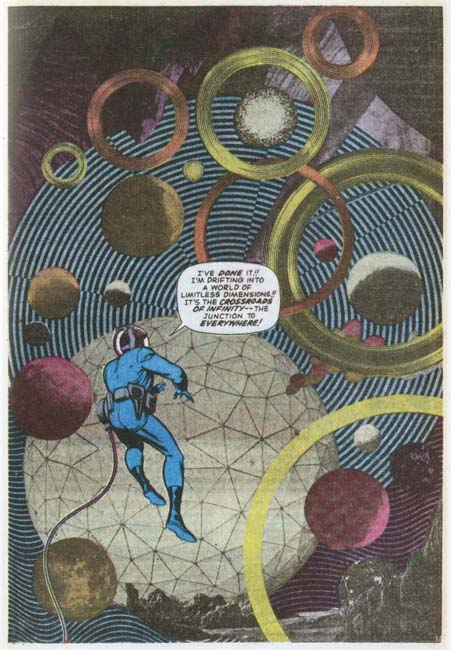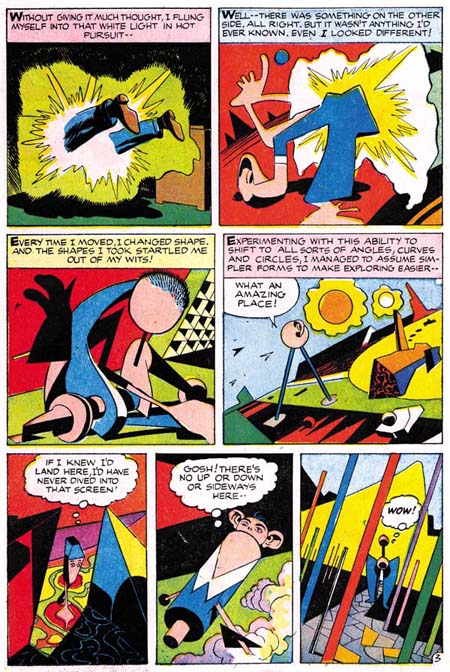
Fantastic Four #51 (June 1966) “This Man, This Monster” page 13, pencils by Jack Kirby, inks by Joe Sinnott, letters by Artie Simek, image from “Hands of Fire”
I am currently reading Charles Hatfield’s “Hands of Fire”. I am sure I will write something about the book in the near future but I thought I would discuss one of the many items Hatfield touches upon. Fantastic Four #51 (June 1966) has the story “This Man, This Monster” in which Mr. Fantastic, Richard Reed, visits the Negative Zone. I do not have the original comic but I use instead a plate from Hatfield’s book which looks to me like it was scanned from the actual comic book. Note panel 3 where Reed exclaims:
IT’S ALMOST MORE THAN HUMAN EYES CAN BEAR! I’M ACTUALLY WHITNESSING A FOUR DIMENSIONAL UNIVERSE – BUT THE EFFECT OF SEEING IT WITH THREE-DIMENSIONAL VISION IS INDESCRIBABLE
But who needs words when we have Jack Kirby to provide an illustration. Off course even Kirby found it difficult to translate four dimensions into just two. The task might be theoretically impossible but the scene that Jack provides is clearly unlike any the reader has ever seen. In the next panel anything remotely naturalistic is replaced with abstract colors.

Fantastic Four #51 (June 1966) “This Man, This Monster” page 14, pencils by Jack Kirby, inks by Joe Sinnott, letters by Artie Simek, image from “Hands of Fire”
As “otherworldly” as the images from page 13, on the next page Kirby presents ultimate in non-reality. Here on the figure of Mr. Fantastic is drawn while the rest is a collage. Kirby was not the first to use photographs from magazines and newspapers in a comic book. However previous uses were rather mundane shortcuts to creating an image and nothing like the innovative collages that Kirby created. The image Jack constructed for page 14 is particularly effective. Photographs gain an acceptance as “truth” that a drawing does not provide. Sure our logical minds know that photographs really are not necessarily true, particularly today with software like Photoshop. However our emotional reaction still accepts photographs as depicting truth. Kirby plays off the photographic “truth” against an scenery that is obviously unreal. That tension is something that a drawing could never quite create.

Blue Bolt #5 (October 1940) page 5, pencils by Jack Kirby, inks by Joe Simon
Mr. Fantastic’s visit to the Negative Zone was not Kirby’s first depiction of the Fourth Dimension, not by a long shot. His earliest occurred in collaboration with Joe Simon in Blue Bolt #5 (October 1940). Blue Bolt enters the Fourth Dimension through a cylinder surrounded by the earliest example of Kirby Krackle (Evolution of Kirby Krackle). On entry the hero is presented with an “odd looking landscape” reminiscent of the effect found in Fantastic Four #51. Blue Bolt then finds he can see through objects and requires special goggles to see in three dimensions.

Alarming Tales #1 (September 1957) “The Fourth Dimension is a Many Splattered Thing”, pencils and inks by Jack Kirby
Kirby would return to the Fourth Dimension theme in an appropriately titled story “The Fourth Dimension is a Many Splattered Thing”. This work was done in collaboration with Joe Simon but after the breakup of their studio. Here Jack’s attempt to draw the indescribable result in some of the most unique images from his career.
Kirby had a long career as a comic book artist. It is surprising how certain themes show up repeated at different points in his career. The Fourth Dimension and Kirby Krackle are just two examples of this phenomenon. If it was just one or two incidences like this it would be easy to write it off as of not great significance. But actually there are many more examples that can be found (and I am sure I will post others from time to time). This signifies to me that Kirby was much more than an illustrator to the stories that he worked on. This is not to denigrate individuals like Joe Simon or Stan Lee for their contributions were also important.


Pingback: Top 10 four-dimensional novels | Mark Blacklock | Books - The Trend Public: Breaking News, India News, Sports News and Live Updates
Pingback: The Guardian | Top 10 des quatre dimensions de romans | Marque Blacklock | La revue de web des livres